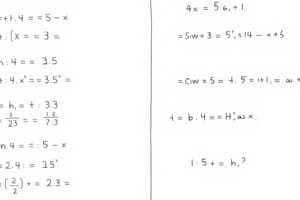Podcast
Questions and Answers
Which operation does the distributive property apply to according to the text?
Which operation does the distributive property apply to according to the text?
- Multiplication (correct)
- Addition
- Division
- Subtraction
Which property does not hold for subtraction according to the text?
Which property does not hold for subtraction according to the text?
- Distributive property
- Commutative property (correct)
- Identity property
- Associative property
What is the act of combining two or more numbers to obtain a single result called?
What is the act of combining two or more numbers to obtain a single result called?
- Division
- Addition (correct)
- Multiplication
- Subtraction
What defines a perfect square?
What defines a perfect square?
What is the rule for division mentioned in the text?
What is the rule for division mentioned in the text?
Which type of number is only divisible by 1 and itself?
Which type of number is only divisible by 1 and itself?
What is the characteristic of an odd number?
What is the characteristic of an odd number?
How are multiples related to a given number?
How are multiples related to a given number?
What method is recommended in the text for solving a system of linear equations?
What method is recommended in the text for solving a system of linear equations?
Where do the solutions to a system of linear equations lie?
Where do the solutions to a system of linear equations lie?
Which real-world application is NOT mentioned for linear equations in the text?
Which real-world application is NOT mentioned for linear equations in the text?
What is the formula to calculate the slope of a line in a graphical representation of a linear equation?
What is the formula to calculate the slope of a line in a graphical representation of a linear equation?
In the equation y = mx + b, what does the constant term 'b' represent in the graph of a linear equation?
In the equation y = mx + b, what does the constant term 'b' represent in the graph of a linear equation?
Which method can be used to solve linear equations besides the slope-intercept form, substitution, or elimination methods?
Which method can be used to solve linear equations besides the slope-intercept form, substitution, or elimination methods?
For the linear equation 3x + 2y = 12, if one point that satisfies the equation is (1, 6), what is the other point that can be plotted on a coordinate plane to represent this equation?
For the linear equation 3x + 2y = 12, if one point that satisfies the equation is (1, 6), what is the other point that can be plotted on a coordinate plane to represent this equation?
Flashcards are hidden until you start studying
Study Notes
Maths Class 10 Exercise 1.1: Arithmetic and Number Properties
In this educational article, we'll dive into the concepts of Maths Class 10 Exercise 1.1, focusing on arithmetic and number properties. These topics form the foundation of understanding mathematical operations and relationships between numbers.
1. Arithmetic
Arithmetic is the branch of mathematics that studies the basic operations of addition, subtraction, multiplication, and division. These four operations enable us to solve a wide variety of real-world problems, such as calculating the cost of an item or the area of a rectangle.
1.1.1 Addition
Addition is the act of combining two or more numbers to obtain a single result. The commutative property of addition states that the order in which the numbers are added does not matter. In other words, A + B = B + A.
1.1.2 Subtraction
Subtraction is the act of finding the difference between two numbers. The commutative property does not hold for subtraction. For example, A - B ≠ B - A.
1.1.3 Multiplication
Multiplication is the act of adding a given number (multiplicand) a specified number of times (multiplier). The distributive property states that A(B + C) = AB + AC.
1.1.4 Division
Division is the act of finding the quotient of dividing one number (dividend) by another (divisor). The quotient rule states that A ÷ B = B/A.
2. Number Properties
Number properties describe the characteristics and relationships between numbers. Here are some common number properties:
2.1. Positive and Negative Numbers
Numbers can be classified as positive (greater than zero) or negative (less than zero). The absolute value of a number represents its distance from zero on the number line.
2.2. Odd and Even Numbers
Numbers are classified as odd (not divisible by 2) or even (divisible by 2).
2.3. Prime and Composite Numbers
Prime numbers are only divisible by 1 and themselves, while composite numbers are divisible by numbers other than 1 and themselves. The first few prime numbers are 2, 3, 5, 7, 11, 13, and 17.
2.4. Perfect Squares and Perfect Cubes
Perfect squares are the result of multiplying a number by itself, while perfect cubes are the result of multiplying a number by itself three times.
2.5. Factors and Multiples
Factors are the numbers that multiply to form a given number. Multiples are the numbers that result from multiplying a given number by an integer.
2.6. Greatest Common Divisor (GCD)
The GCD is the largest integer that is a common divisor of two or more numbers.
2.7. Least Common Multiple (LCM)
The LCM is the smallest integer that is a multiple of two or more numbers.
In Mathematics Class 10 Exercise 1.1, students will focus on understanding these fundamental concepts and how they interact with each other. With a strong grasp of arithmetic and number properties, students will be well-equipped to tackle more advanced mathematics topics in the future.
Studying That Suits You
Use AI to generate personalized quizzes and flashcards to suit your learning preferences.




